In an era where technological advancement is not just a boon but a necessity, artificial intelligence (AI) and automation are transforming the workplace in profound ways. In this exploration of AI and the future of work, we investigate how artificial intelligence and automation are revolutionizing workplaces, impacting job roles, and altering organizational dynamics. We'll explore both the potential advantages and challenges presented by AI in the workplace, offering insights into how employees and employers alike can navigate this evolving landscape. From understanding the latest automation trends that are reshaping industries to preparing for the future of work, this guide aims to equip you with knowledge and strategies to thrive in an AI-enhanced world.
In this blog, you will find:
🤖 AI And Robotics In The Workplace
🧑🏾💻 How Employees Can Prepare For An AI-Driven Work Environment
AI and the Future of Work
Generative AI is opening new doors in the workforce, leading to the evolution of job roles while simultaneously introducing challenges such as job reduction and labor disparities. The dynamic economic landscape is rapidly transforming with AI's integration. Advanced economies may encounter these challenges more immediately, while developing economies, bolstered by a cognitive-driven workforce, might demonstrate greater resilience. While women and those with higher education are poised to benefit significantly from AI advancements, older workers may struggle to keep pace with rapid technological changes. As AI continues to proliferate, we can expect a dual impact: while some jobs may be displaced, new roles will be created, highlighting the need for adaptive skills in the workforce.
AI and Robotics in the Workplace
AI is increasingly being used to automate tasks and enhance efficiency. There are many pros and cons to this rising trend, and one must be wary of both sides of the coin to understand the topic at hand. Let’s delve deeper:
👍Pros:
Improved Efficiency: AI and robots don’t need to take any rest or even leave for home. Hence, they can work 24/7 and increase the productivity of a company.
Save Finances: Organizations can reduce labor costs by automating repetitive and simpler tasks, which will have the additional benefit of reducing the human error factor in transactional processes.
Enhanced Safety: Workplace safety can be increased by the use of robots in dangerous conditions instead of placing humans in a difficult situation.
Precision: Robots and AI offer precise and accurate results every time as opposed to the unpredictability of human error. This can improve output drastically and create flawless products every time.
Personalized Customer Service: Through AI-powered chatbots and virtual assistants, a more personalized customer care plan can be sketched out, which improves enduring customer loyalty.
👎Cons:
Loss of Jobs: As AI and robots become mainstream, some industries, particularly those that rely on manual labor, could experience a drastic loss of jobs.
Technical issues: On the other hand, with the increased use of robotic systems, there are more chances of complex technical failures that will be difficult to decipher, which could lead to lost productivity.
Security Issues: Cyber attacks will become increasingly common, as the use of AI means sensitive information will be available online, perhaps in a vulnerable location. Intellectual property could be claimed through cyber attacks without any chance of return.
Lack of Creativity: Robots and AI cannot replace human creativity and problem-solving approaches. They can only mimic repetitive processes.
Ethical Issues: AI and robots can negatively affect society and may lead to misuse of AI technologies for personal and professional gain.
How employees can prepare for an AI-driven work environment
In an increasingly AI-driven world, preparing employees for the shifts in the workplace is crucial. Here’s how employers and employees can work together to navigate this transition effectively:
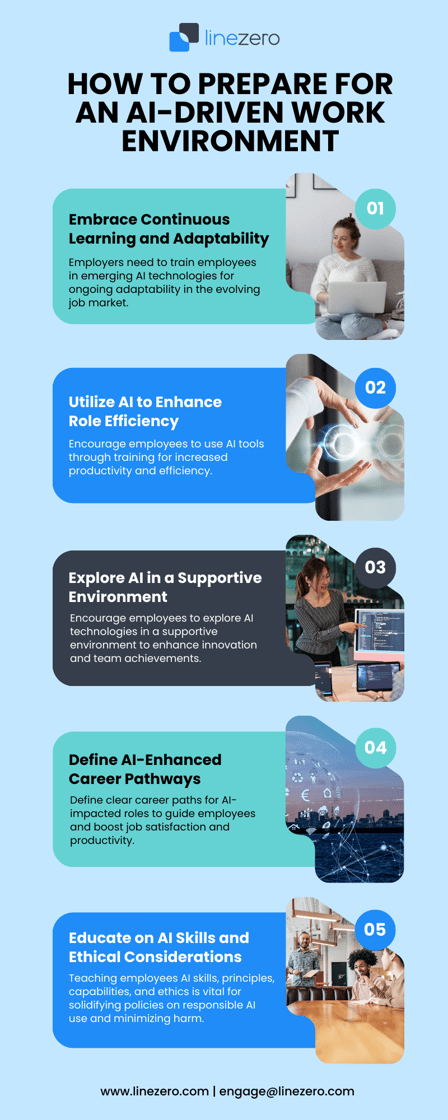
1. Embrace Continuous Learning and Adaptability
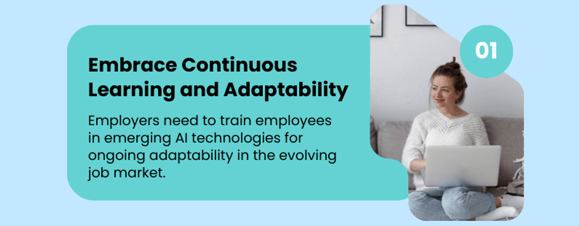
Employers play a vital role in providing training and resources on emerging technologies. By fostering a culture of continuous learning, employees become more adaptable to change. Upskilling in AI and related technologies is essential to remain relevant and competitive in the evolving job market.
2. Utilize AI to Enhance Role Efficiency
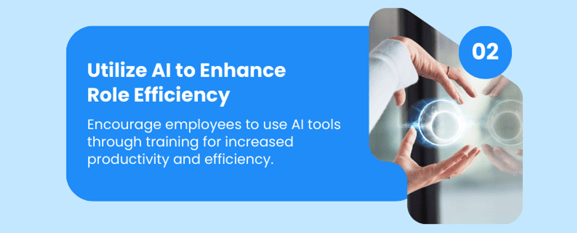
Employees should be encouraged to leverage AI tools within their roles. Through comprehensive training programs, workers can become proficient in using AI to make informed, data-driven decisions. This not only increases individual productivity but also enhances the overall efficiency of the organization.
3. Explore AI in a Supportive Environment
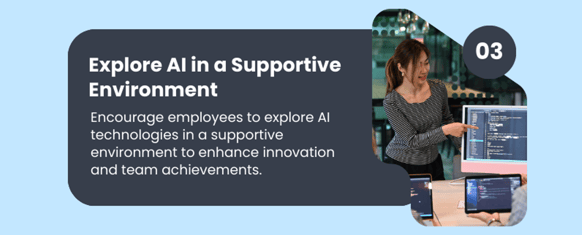
It’s important for employees to explore AI technologies and understand their applications in a supportive, non-toxic environment. This exploration can lead to innovation and the development of new technologies that harmoniously integrate AI with human efforts, pushing the boundaries of what teams can achieve together.
4. Define AI-Enhanced Career Pathways
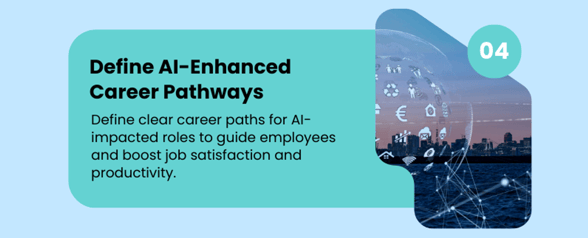
Clear career pathways should be defined for roles that are likely to be transformed by AI, giving employees a clear sense of purpose and direction. Structured career development plans help in fostering job advancement opportunities, thereby enhancing job satisfaction and productivity.
5. Educate on AI Skills and Ethical Considerations
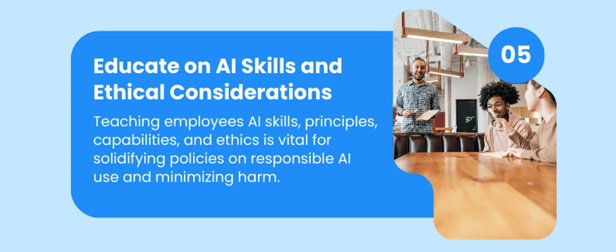
Education on AI-specific skills necessary for automating processes is crucial. Employees should not only know how to use AI tools but also understand the underlying principles and capabilities of these technologies. Furthermore, it’s critical to educate staff about the ethical considerations surrounding AI and robotics. Organizations must develop strong policy frameworks and ethical guidelines to ensure AI technologies are used responsibly and that any potential harm is minimized.
By taking these steps, businesses can empower their workforce to thrive in an AI-enhanced environment, ensuring that the transition to more automated processes is smooth and beneficial for all stakeholders involved.
As we explore how to prepare employees for an AI-enhanced workplace, it's also crucial to look at the broader automation trends driving digital transformation. Let's dive into the top five automation trends reshaping IT automation and guiding organizational change across industries.
Top 5 Automation Trends
The following five automation trends are reshaping IT automation and driving digital transformation in the workplace.
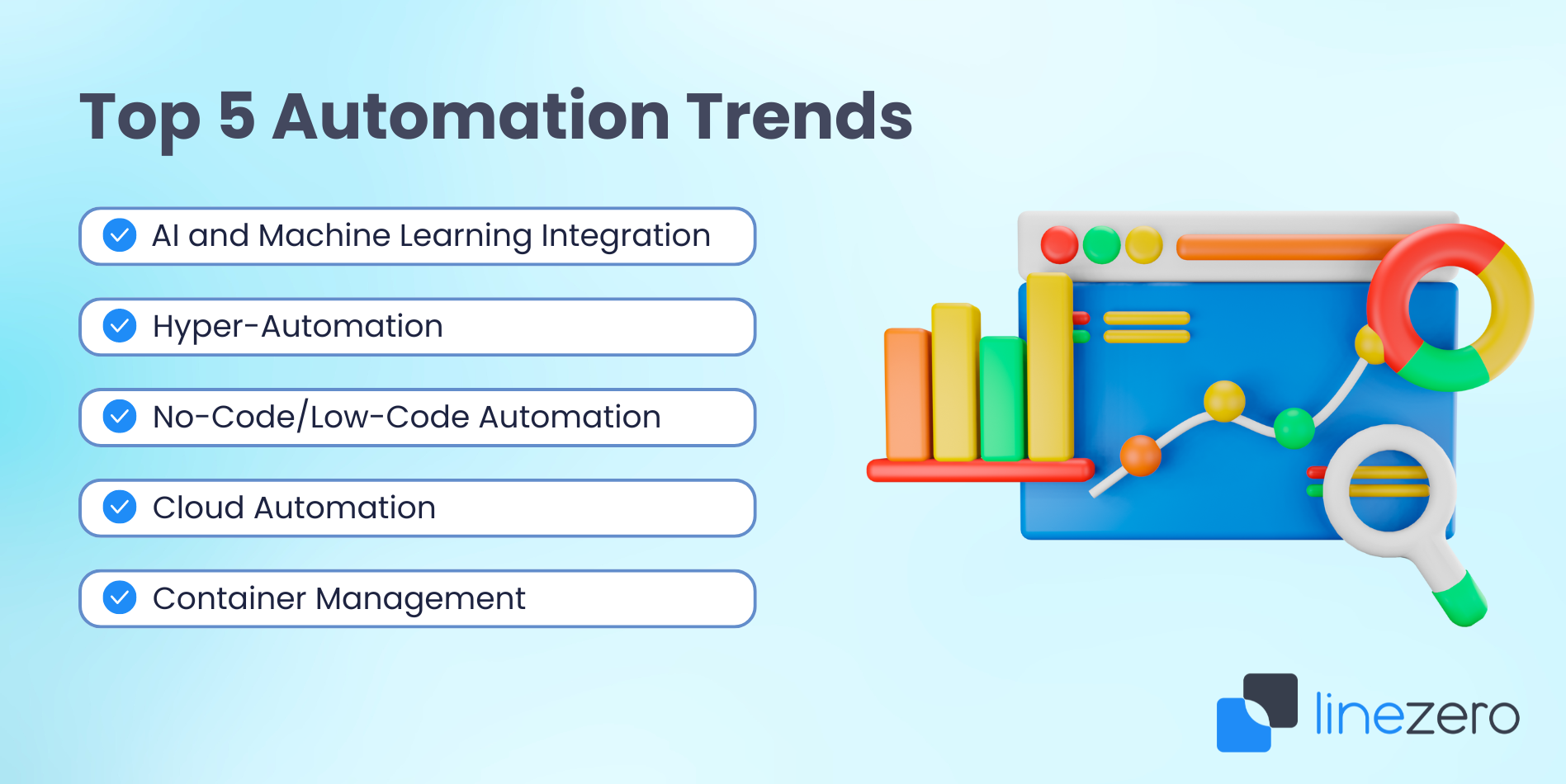
1. AI and Machine Learning Integration
Set out to be a part of 90% of enterprise apps by 2025, AI and Machine Learning technologies are revolutionizing automation. From automated machine learning (AutoML) to intelligent document processing (IDP), these technologies optimize processes and decision-making.
2. Hyper-automation
Combining AI/ML with various automation tools like RPA and BPA, hyper-automation facilitates end-to-end business process automation. This approach ensures heightened efficiency and agility, which are the key elements in successful digital transformation strategies.
3. No-Code/Low-Code Automation
70% of new apps will adopt low-code technologies by 2025. Low-code/no-code platforms empower non-technical users to create applications and automate processes, streamlining automation efforts.
4. Cloud Automation
With 40% of enterprise workloads transitioning to the cloud, IT automation aids in managing and orchestrating complex cloud environments, enabling scalability and hybrid cloud adoption.
5. Container Management
75% of large enterprises will embrace container management by 2024. IT automation streamlines container lifecycles, which are adding, changing, or revising large quantities of software containers.
Ethical considerations
AI ethics should be of great interest to any company that uses AI and Machine Learning automation. Although AI reduces costs and human error drastically, it also replaces human jobs, as, according to McKinsey, 15% of all jobs will be displaced by 2030. Also, with the rising use of ChatGPT and other content creation AI tools, issues around content ownership and attribution have risen drastically. This requires lawmakers to create an AI Code of Conduct to mitigate the associated risks. Lastly, because of AI, information is being uploaded in large quantities. Companies need to be wary of unauthorized access and breach of sensitive information and should require safeguarding measures to uphold data privacy.
Conclusion
In conclusion, AI and the future of work present transformative potential for the workplace. By understanding and leveraging the top automation trends, businesses can enhance their operational efficiency and foster a more dynamic and innovative work environment. Moreover, by proactively preparing employees through continuous learning, ethical training, and adaptable career pathways, organizations can ensure that their workforce is not only ready but also thriving in this new era. Ultimately, the successful integration of AI into the workplace hinges on a balanced approach that maximizes benefits while addressing potential challenges, ensuring that the future of work is advantageous for all stakeholders.
Are you ready to be part of the future of work?
The future of work is with LineZero!
At LineZero, we partner with Meta to empower businesses like yours through cutting-edge mixed reality (MR) and virtual reality (VR) solutions, tailored for today’s digital workplace.
Start Your Digital Transformation Journey Today!

April 16, 2024




Comments